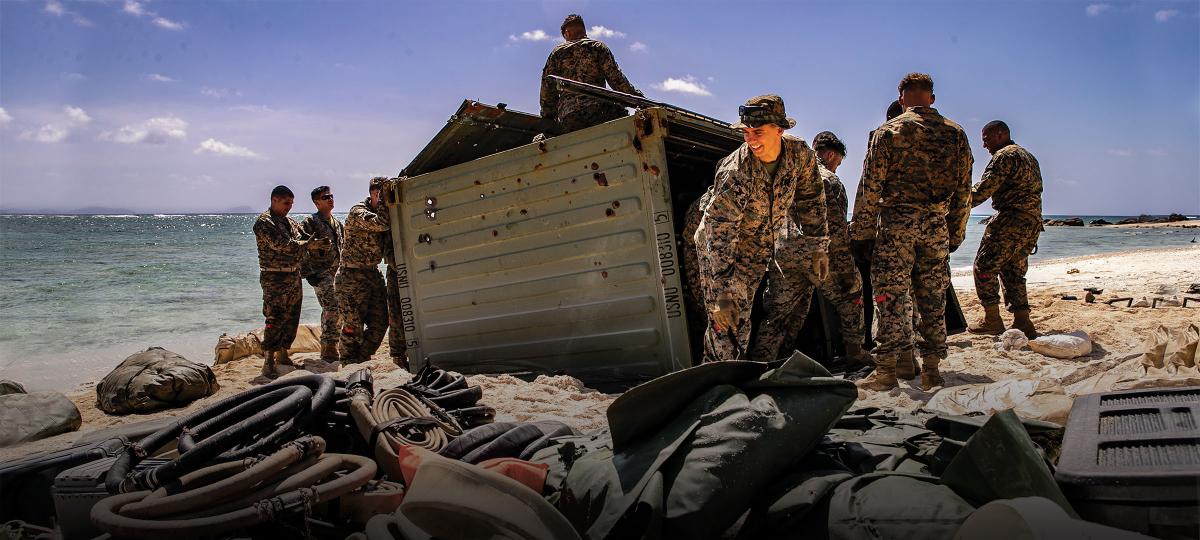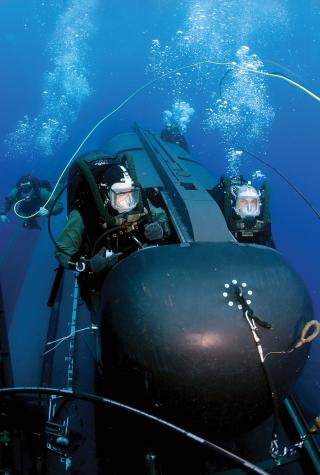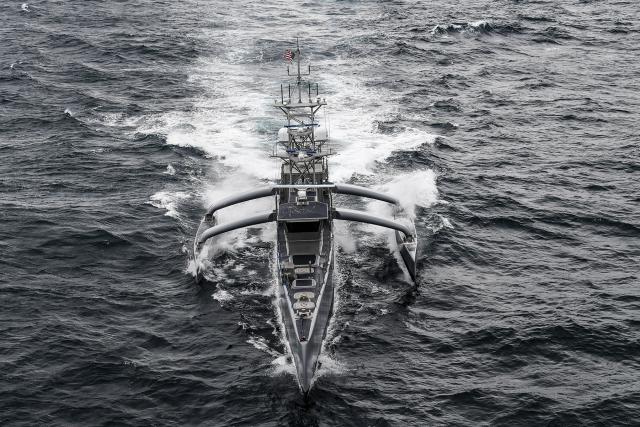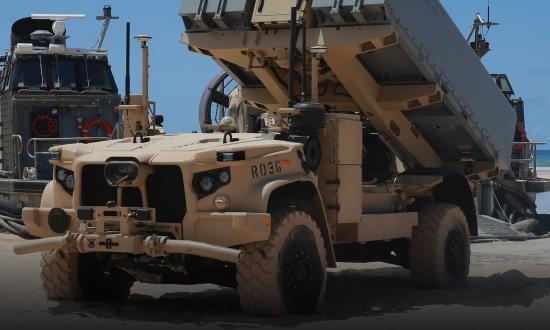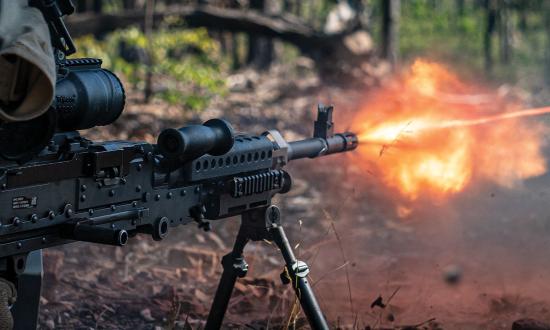In his Commandant’s Planning Guidance, Marine Corps Commandant General David H. Berger outlines the importance of expeditionary advanced base operations (EABO) in a possible fight with China. He states that EABO will “enable naval forces to partner and persist forward to control and deny contested areas where legacy naval forces cannot be prudently employed without accepting disproportionate risk.” Berger goes on to say that to support EABO, the Navy and Marine Corps will need improved logistics capabilities: “We must reimagine our amphibious ship capabilities, prepositioning, and expeditionary logistics so they are more survivable, at less risk of catastrophic loss, and agile in their employment.”1 If used for logistics, unmanned underwater vehicles (UUVs) and unmanned surface vessels (USVs) could support EABO by fulfilling all three of the Commandant’s requirements.
Traditional Resupply Won’t Work
Ground commanders have greater flexibility than their naval counterparts in resupplying their combat forces. Munitions, fuel, spare parts, food, and water can be brought to the forward line of troops by a variety of ground or air platforms, each with benefits and drawbacks. From a logistical standpoint, however, conventional means of resupply are not viable for EABs. The Chinese military’s heavy investment in antiaccess/area-denial weapon systems poses a serious risk for existing Sea Service logistics platforms.2
Moving supplies with surface and aerial platforms puts those platforms at risk of being detected and intercepted when operating within the threat envelope of Chinese weapons and sensors. Even if surface ships launch ship-to-shore connectors such as helicopters or landing craft air cushion vehicles, they still would be forced to operate in the same threat envelope because of the short range of the connecting platforms.3 The capability to reliably resupply Marine Corps forces within the range of enemy weapon systems will be critical to supporting EABO.
delivery vehicle is a testament to the concept of using submerged platforms to clandestinely move from a naval platform to shore and back. Credit: U.S. Navy
The Unmanned Advantage
Similar to the flexibility and the variety of logistics platforms that ground commanders have at their disposal, UUVs and USVs can increase flexibility for naval commanders. Navies worldwide already have used UUVs for a variety of purposes, ranging from reconnaissance, to search and rescue and mine countermeasures.4 The U.S. Navy also is evaluating USV and UUV prototypes for future use.5 One USV recently completed a transit of the Panama Canal.6 Such versatile platforms could be adapted to resupply warships at sea and Marine Corps forces on land.
Using UUVs for resupply has distinct advantages. In addition to being stealthy, they also are difficult to destroy. To destroy a submerged vessel, a platform with antisubmarine weapon systems must be close enough to both detect it and deploy weapons against it. In addition, a resupply drone would create a low payoff dilemma for an adversary. To stop these drones, ASW-capable platforms would have to be diverted from hunting dangerous U.S. fast-attack or guided-missile submarines that pose an imminent and deadly threat. Furthermore, these ASW platforms also would be faced with the threat of an EAB’s weapon systems.
While UUVs have significant advantages, USVs have their own. Less stealthy but cheaper and simpler, USVs with greater cargo capacity may be used for most resupply operations. This would allow UUVs to be reserved for covert missions. If the Navy were to design a hybrid of the two platforms, it could operate similar to narco-subs.7 Most narcosubs are not true submarines, but rather semisubmersible surface vessels with very little freeboard.8 While their stealth advantage is not as great as that of UUVs, semisubmersibles would be substantially cheaper and simpler to produce in large numbers than UUVs. Similar to the Liberty ships of World War II, large numbers of USVs could be constructed at comparatively low cost and in a shorter time. Since they are surface vessels, their cargo capacity could be further increased by towing dracone barges.
USV swarms would allow for redundancy as well as the simultaneous resupply of distributed forces. This also would further complicate an adversary’s attempts to interdict resupply operations. Rather than hunting down and killing a single large, slow, vulnerable surface ship, a mothership could deploy multiple USVs—and even UUVs—outside the adversary’s weapon systems range. This would force the adversary to hunt and destroy each individual drone rather than simply tracking and destroying a surface ship moving between advanced bases or warships and resupplying them one at a time.9
These swarms also could be prepositioned near land-based Marine Corps forces and warships that will need to be resupplied. If a Marine Corps landing force were dispatched to seize an island within the range of threat weapon systems, surface ships would be needed to support the landing with air defense and gunfire support. Following the landing, these ships would require fuel and munitions, and the Marines would need fuel, ammunition, replacement parts, and food. Drones could be used to resupply both warships and forces ashore. UUVs with supplies for the landing force could loiter on the seafloor near the objective area before the landing force arrives. Similarly, UUVs and USVs with supplies
for the warships could loiter near the vessels supporting the landing.
Drawbacks of Unmanned Cargo Carriers
As of now, there are no unmanned cargo platforms in the Sea Services.10 However, vessels with similar characteristics and capabilities exist. They could be modified to serve as cargo carriers, and their capabilities could be incorporated in future purpose-built cargo-carrying UUVs.
The SEAL delivery vehicle (SDV), operated by the Navy for decades, is one example. While it is limited in range and cargo capacity, it is a testament to using submerged platforms to move clandestinely from a naval platform to shore and back.11 The Navy also has adopted newer UUVs with substantially greater endurance, such as the diesel-electric powered Orca Extra Large UUV (XLUUV). This platform can travel up to 6,500 nautical miles (nm), stay at sea for months, and be outfitted to conduct “mine countermeasures, antisubmarine warfare, antisurface warfare, electronic warfare, and strike missions.”12 In the future, purpose-built XLUUVs could be used as cargo carriers to fill the role of a stealthy, unmanned, long-range logistics platform.
While UUVs have tremendous advantages when compared with other platforms, they still have shortcomings. Because of their small size, UUVs would have limited cargo capacity. This would require either a new design of even larger UUVs or a higher number of UUVs built to make up for their lack of cargo capacity. USVs also may be able to help make up for this reduced cargo-carrying capacity.
While unloading supplies from a USV would be no different from a surface ship, UUVs would require special considerations. For a UUV to transport cargo underwater, it would have to be kept in a watertight container—either a pressure hull integral to the UUV itself or in a removable pressure vessel. Both designs have limitations. A removable pressure vessel would allow for a faster transfer of cargo from a UUV but require the construction of many pressure hulls, as a new one would be required for each mission. On the other hand, a pressure hull integral to the UUV would make unloading cargo substantially more complicated.
In either case, resupplying land forces using UUVs is a method that must be developed. EABs probably will not have facilities capable of off-loading supplies from cargo vessels. However, the Marine Corps may already have a solution. The recovery variant of the amphibious combat vehicle (ACV), soon to replace the amphibious assault vehicle, could use its crane to lift cargo from a UUV and transfer it to an empty ACV. These ACVs—with their three-and-a-half-ton cargo capacity—would then carry the cargo ashore.13
Another question concerning the use of USVs and UUVs is from where they would be deployed. Given the 6,500-nm range of an Orca XLUUV, a drone could be launched from Japan or Guam and make a round trip to the South China Sea. USVs could have an even greater endurance in the future. The Defense Advanced Research Projects Agency currently is developing
a system that could push the range of USVs up to 14,000 nm.14
In addition to launching UUVs from land bases, a mothership could be used to launch and recover cargo UUVs at sea. This would allow increased responsiveness and greater efficiency. UUVs could conduct more missions since a mothership could carry them close to the forces in need of supplies while remaining at a standoff distance. A semisubmersible surface ship such as the new expeditionary transfer dock would be an ideal mothership, as it supports a swim-on, swim-off capability.15 Furthermore, such a ship could carry a large number of UUVs and USVs.
In future operations, UUV and USVs will not completely replace traditional means of supplying Navy and Marine Corps forces. Rather, they will supplement them by providing platforms to move supplies on high-risk missions within the threat range of an adversary’s weapon systems, as will be required in EABO. These platforms could fulfill the requirements General Berger outlined perfectly: they are more survivable, at less risk of catastrophic loss, and agile in their employment. Whether they would be launched from naval bases or ships at sea, unmanned cargo vessels will be a game changer for logistics in a contested environment.
1. Gen David H. Berger, Commandant’s Planning Guidance (Washington, DC: Headquarters Marine Corps), 16 July 2019.
2. Capt Walker Mills, USMC, and Erik Limpaecher, “Sustainment Will Be Contested,” U.S. Naval Institute Proceedings 146, no. 11 (November 2020).
3. Maj Scott Cuomo, USMC, and Billy Birdzell, “Submarine Stormtroops,” U.S. Naval Institute Proceedings 138, no. 11 (November 2012).
4. CDR Fritz-Ruediger Klocke, GN, “Mine-hunting Autonomous Underwater Vehicle Trials Successful,” U.S. Naval Institute Proceedings 130, no. 12 (December 2004); Megan Eckstein, “USV, UUV Squadrons Testing Out Concepts Ahead of Delivery of Their Vehicles,” USNI News, 9 September, 2020.
5. Megan Eckstein, “Navy Pushing to Maintain 2023 USV Program of Record Timeline,” USNI News, 8 September 2020.
6. Megan Eckstein, “Pentagon ‘Ghost Fleet’ Ship Makes Record-Breaking Trip from Mobile to California,” USNI News, 10 November 2020.
7. LtCols Brandon Turner and Jason Garza, USMC, “Fighting (and Deceiving) to Get to the Fight,” U.S. Naval Institute Proceedings 145, no. 11 (November 2019).
8. CDR Craig Allen, USCG, and Casey Allen, “20,000 Drones Under the Sea,” U.S. Naval Institute Proceedings 144, no. 7 (July 2018).
9. Megan Eckstein, “Navy, Marines Moving Ahead with Unmanned Vessel Programs,” USNI News, 31 October 2019.
10. Ronald O’Rourke, “Navy Large Unmanned Surface and Undersea Vehicles: Background and Issues for Congress,” Congressional Research Service, 10 November 2020.
11. “SEAL Delivery Vehicles,” Navy SEAL Museum, National Navy UDT-SEAL Museum (2020).
12. Ben Werner, “Navy Awards Boeing $43 Million to Build Four Orca XLUUVs,” USNI News, 13 February 2019.
13. BAE Systems, “Amphibious Combat Vehicle” (2020), www.baesystems.com/en/product/amphibious-combat-vehicle.
14 Mallory Shelbourne, “DARPA Aiming to Increase USV Range with Sea Trains Program,” USNI News, 2 November 2020.
15. General Dynamics NASSCO, “ESD Program” (2020).



